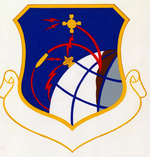Western Range (USSF)
This article focuses only onone specialized aspect of the subject.(July 2013) |
| Part ofa serieson the |
| United States space program |
|---|
  |

TheWestern Range (WR)[1]is thespace launch rangethat supports themajor launch headatVandenberg Space Force Base.[2]: pg 15 Managed by theSpace Launch Delta 30,[3]: pg 25 theWRextends from the West Coast of the United States to 90° East longitude in theIndian Ocean[3]: pg 27 where it meets theEastern Range[4]: pg 10 Operations involve military, government, and commercial interests. TheWRhas been operated by civilian contractors since its establishment, following the precedent of the Eastern Range. On 1 October 2003, InDyne Inc. took over the range contract fromITT Industrieswhich had operated the range for the previous 44 years.[5]
History[edit]
[edit]
The Navy established the Naval Missile Facility at Point Arguello (NMFPA) after the transfer from the Army of 19,800 acres from the southern portion of Camp Cooke in May 1958. Camp Cooke was a World War II training and POW facility and a maximum security Disciplinary Barracks site.[6]Cooke Air Force Base, laterVandenberg Space Force Base,was established on 64,000 acres of the northern portion.[6]The Secretary of Defense directed the Navy to establish the Pacific Missile Range (PMR) with headquarters atPoint Muguand instrumentation sites along the California coast and downrange in the Pacific Ocean.[6]Agreements between the Navy and the Air Force specified that nearly all launches fromVandenberg Space Force Basewere under the command and control of Navy and the PMR.[6]
A PacificMissile Impact Location System(MILS) was installed to support bothIntermediate Range Ballistic Missile(IRBM) andIntercontinental Ballistic Missile(ICBM) tests. IRBM impacts were northeast of Hawaii and covered by a system terminating at theMarine Corps Air Station Kaneohe Bayoperational November 1958. The ICBM impacts required MILS monitoring betweenMidway IslandandWake Islandand between Wake Island andEniwetok.Two target arrays and a Broad Ocean Area (BOA) array system were installed. The ICBM range was operational in May 1959 with two target arrays. MILS shore facilities were at Kaneohe and each of the islands.[7][8]
Air Force — Western Test Range[edit]
Secretary of DefenseRobert S. McNamaradirected a restructure of the missile ranges on 16 November 1963 with an effective date of 1 July 1964. This restructure shifted responsibility of major sections of the Navy's Pacific Missile Range to the United States Air Force.[6]In a final transfer, on 1 February 1965, the Air Force, with headquarters at Vandenberg Air Force Base, took control ofPillar Point,California,two sites inHawaii,Canton Island,Midway Island,andWake Islandin the mid-Pacific as well asEniwetokandBikini Atollin theMarshall Islands.[6]The Air Force also took control of the six range instrumented shipsHuntsville,Longview,Range Tracker,Richfield,Sunnyvale,andWatertown.[6]The Navy retained a missile test facility atPoint Mugu.[6]In 1979, the name was shortened to simply the Western Test Range.[6]
Notable launches[edit]
- 28 February 1959 -Discoverer 1- first spacecraft placed in apolar orbit.[6][9]
- 29 September 2013 –Falcon 9 Flight 6,the first launch of theFalcon 9v1.1 launch vehicle from aprivately developedleased launchpad atVandenberg Air Force Basewas used in an unusual post-mission launch vehicle test.[10]Thefirst-stage boosterof theSpaceXFalcon 9launch vehicle will conduct apropulsive-return over-water test.After the second stage with theCASSIOPEpayloadseparatesfrom the booster, the booster will do a retro burn to reduce velocity from approximately Mach 10 (12,300 km/h; 7,610 mph) to acontrollabledescent velocity, and then a second burn just before it reaches the water to simulate avertical landingof the first stage.[11]This will be the first high-altitude, high-velocity test of theSpaceX reusable launch system development program.
See also[edit]
References[edit]
- ^Federation of American Scientists.
- ^"Chapter 1: Eastern and Western Range Safety Policies and Processes 31 December 1999 Change to 1997 EWR"(PDF).Retrieved31 August2008.
- ^abCenter for Aerospace Technology (CAST) (February 2000)."30th SPACE WING / VANDENBERG AIR FORCE BASE LAUNCH SITE SAFETY ASSESSMENT"(PDF).Research Triangle Institute Center for Aerospace Technology (CAST).Federal Aviation Administration Associate Administrator for Commercial Space Transportation.Retrieved31 August2008.
- ^Loyd C. Parker; Jerry D. Watson; James F. Stephenson (July 1989)."BASELINE ASSESSMENT WESTERN SPACE AND MISSILE CENTER"(PDF).RESEARCH TRIANGLE INSTITUTE CENTER FOR SYSTEMS ENGINEERING FLORIDA OFFICE for U.S. DEPARTMENT OF TRANSPORTATION OFFICE OF COMMERCIAL SPACE TRANSPORTATION. Archived fromthe original(PDF)on 9 August 2016.
- ^Janene Scully (14 July 2003)."New leader of Western Range signed at VAFB"(PDF).Santa Maria Times.Pulitzer Central Coast Newspapers.Retrieved2 June2008.
- ^abcdefghij30th Space Wing History Office.
- ^Subcommittee on Military Construction (March-April) (29 April 1959).Military Construction Appropriations for 1960: Hearings.pp. 169–170.Retrieved16 September2020.
- ^Subcommittee on Military Construction (May) (20 May 1959).Military Construction Appropriations for 1960: Hearings.pp. 818, 824.Retrieved16 September2020.
- ^"NASA - NSSDC - Spacecraft - Details NSSDC ID: 1959-002A".Retrieved31 August2008.
- ^Foust, Jeff (27 March 2013)."After Dragon, SpaceX's focus returns to Falcon".NewSpace Journal.Retrieved5 April2013.
- ^Lindsey, Clark (28 March 2013)."SpaceX moving quickly towards fly-back first stage".NewSpace Watch.Retrieved29 March2013.
Bibliography[edit]
- "Western Range (U)".Federation of American Scientists.Retrieved16 June2015.
- Gruss, Mike (6 April 2015)."Raytheon Team Wins US$2 Billion Air Force Range Support Contract".SpaceNews.Retrieved8 April2015.
- 30th Space Wing History Office."U.S. Air Force Fact Sheet".30th Space Wing Public Affairs. Archived fromthe originalon 10 January 2015.Retrieved16 June2015.
{{cite web}}:CS1 maint: numeric names: authors list (link)
- Western Test Range Handbook,Defense Technical Information Center, July 1981
